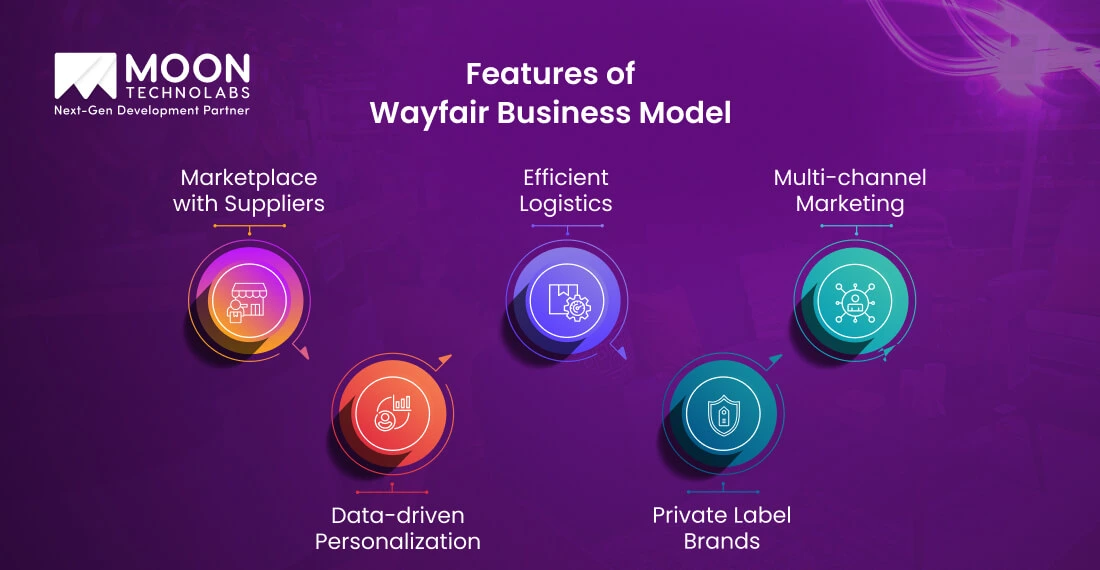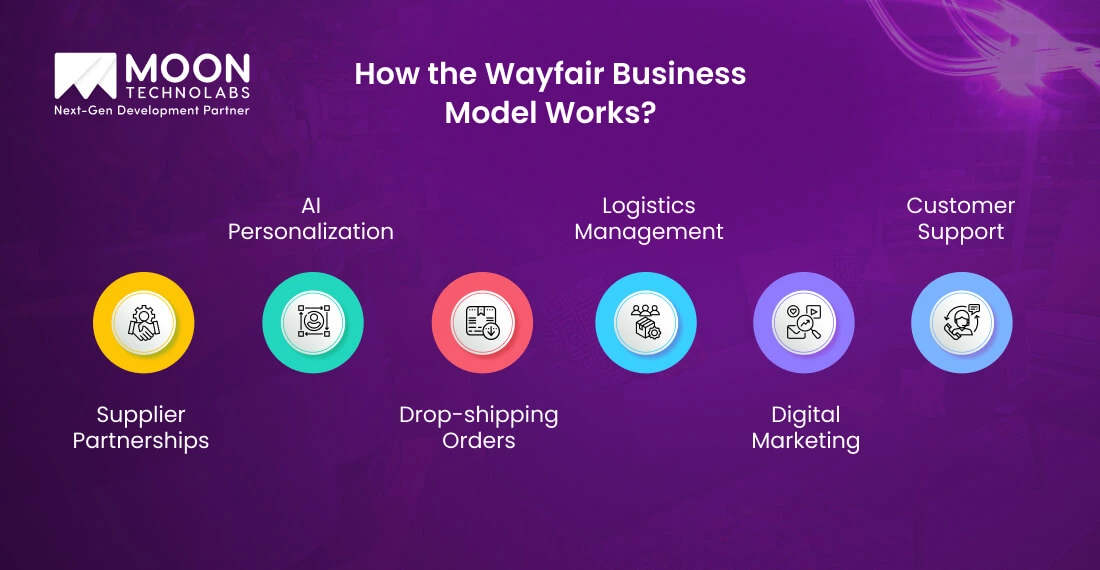Table of Content
Blog Summary:
This post explains the importance of adopting the Wayfair business model, which earned vast acceptance among businesses in this sector. Here, we have covered everything in detail about this model, including features, common challenges, development costs, and many more. It also lets you know why your business should adopt the Wayfair business model. So, start reading now.
Table of Content
Wayfair, which was founded in 2002, is a leading eCommerce platform that serves millions of customers worldwide. It’s popular among customers for offering furniture and home décor items and has a market capitalization of approximately $6.17 billion. The most interesting fact about the brand is that it doesn’t have any physical stores.
You may be excited to learn about the Wayfair Business Model, right? Well, it mainly works on connecting customers directly with suppliers to buy products. Wayfair is just responsible for its marketplace, which lets customers shop conveniently.
Let’s discuss the business model in detail and explain why businesses should adopt it.
Wayfair is a worldwide popular brand that uses drop-shipping business models. It serves as a marketplace where customers can purchase home goods, furniture, etc. The brand doesn’t have a manufacturing unit for the items it sells. Instead, it has partnerships with many suppliers who sell products directly to customers.
Wayfair generates revenue through advertising, product markups, logistic services, and more. It uses artificial intelligence and data analytics to improve customer experience, manage inventory, and determine prices. The company promises fast product delivery through the CastleGate fulfillment network.
Let’s explore some relevant facts and figures of Wayfair’s business model:
You will come across many businesses that have either adopted or are trying to adopt the Wayfair business model. Do you know why? Several things prompt businesses to adopt this model. These include cost-efficiency, scalability, maximizing reach among vast customers, and more.
Let’s explore some other reasons as well:
Our specialists can analyze your business and help you integrate Wayfair-inspired tactics for growth and efficiency.

Several important features play a vital role in defining the overall business model of Wayfair and increasing its popularity globally. We have discussed some of the top features below;
Wayfair collaborates with third-party suppliers and builds a strong partnership with them to serve customers and thus operate businesses successfully. Suppliers list their products on Wayfair’s marketplace.
Partnering with multiple suppliers helps Wayfair sell a wide range of products on its websites and thus serves customers with different needs. The presence of many sellers also allows Wayfair to offer products at competitive prices. Wayfair earns revenue through fulfillment and commission fees.
Wayfair leverages emerging technologies such as big data, AI-based analytics, etc., to monitor search patterns, customer behavior, purchase history, and more. This helps them personalize product recommendations, advertisements, and pricing.
Thus, predictive analytics helps boost customer experience, which leads to vast engagement and enhances customer retention and, thus, conversion rates. It is also useful for optimizing product listings and supply chains more efficiently.
Wayfair is completely different from other traditional retailers. In its business model, sellers are responsible for storing products and sending them directly to customers. Meanwhile, Wayfair improves overall delivery efficiency with its Wayfair Delivery Network (WDN).
It’s a logistic system that can make transportation smooth and convenient. Wayfair minimizes costs while ensuring reliable and quick order fulfillment.
Wayfair has introduced several private-label brands, including Joss & Main, AllModern, and Birch Lane. This helps them sustain in today’s cutthroat market. These brands match various customer preferences and provide exclusive products that are barely available on any other platforms.
This strategy enables Wayfair to maintain perfect control over quality, pricing, brand positioning, and more, which leads to a higher profit margin.
For marketing and promotion, Wayfair adopts several strategies, such as influencer partnerships, digital marketing, search engine optimization (SEO), and social media advertising.
These help them boost traffic and brand visibility. It uses several programmatic advertising to make its reach among targeted audiences and uses mainly retargeting campaigns to bring back many potential customers.
Of course, adopting the Wayfair business model helps businesses avail of numerous benefits. However, it also presents several challenges. Let’s explore some of these challenges;
Businesses need to work hard to create trust, credibility, and transparency to maintain a good relationship with suppliers. Apart from this, it’s also not an easy task to maintain quality control across different suppliers of discrepancies in packaging, product quality, or branding. This leads to customer dissatisfaction and negative reviews.
According to the Wayfair business model, businesses don’t need to own any inventory or warehouse. However, they face many challenges when it comes to coordinating with many suppliers.
It often causes unnecessary supply delays, complex logistics, huge transportation expenses, lost orders, and more. To offer hassle-free operations, businesses must invest in cutting-edge logistic technology and build partnerships with trusted carriers.
With a number of eCommerce providers offering home goods, the landscape is highly competitive. To sustain in the competitive market, businesses provide superior marketing experience, competitive pricing, personalized product recommendations, and more. So, businesses need to focus on creating brand identity, which indeed involves lots of challenges.
Wayfair takes several measures to entice customers—offering discounts and promotions is one of them. Meanwhile, the pricing strategy creates a great margin, which makes it a huge problem to sustain long-term profitability.
Businesses using this model need to properly balance pricing strategies with supplier agreements, operational costs, and marketing expenses.
Managing customer services is another common challenge businesses face when using the drop-shipping model. The reason is that they don’t have control over product quality or fulfillment.
Higher return rates also cause operational costs, especially in this sector. Organizations should always implement clear return policies, automated solutions, and responsive customer support to handle complaints and refunds more efficiently.

Wayfair works on a unique eCommerce business model that enables it to flourish in a cut-throat competitive market. We have provided complete details of the way Wayfair functions and grows here.
As we mentioned already, Wayfair partners with suppliers of different products. These suppliers display their products on the marketplace. They take responsibility for curating product listings, improving product visibility, and optimizing descriptions. The availability of several suppliers ensures a range of home décor and furniture items.
Wayfair uses big data analytics and Artificial Intelligence (AI) to offer personalized shopping experiences. AI-based algorithms can analyze customer preferences, behaviors, browsing history, and more.
It’s essential to recommend many relevant products. Wayfair leverages Augmented Reality (AR) tools, which help customers see furniture in their living space and make a final decision to purchase accordingly.
Since Wayfair uses the drop-shipping model, when customers place orders, the company forwards them directly to sellers. After this, sellers ship products directly to their customers.
This model helps Wayfair minimize storage costs while ensuring a wider selection of products. Meanwhile, great coordination with many suppliers is also required to ensure on-time fulfillment and greater quality control.
Apart from working on the drop-shipping model, the company also strengthened its logistics infrastructure. It operates its fulfillment centers under its WDN, which makes the delivery of even bulky items hassle-free.
Wayfair also uses regional warehouses to improve efficiency and delivery speed, which minimizes its overall reliance on third-party logistics providers.
Wayfair leverages digital marketing’s potential to maximize its reach among products and increase conversions and revenue. It focuses on social media advertising, search engine marketing (SEM), retargeting techniques, email campaigns, and more.
These are essential to many potential buyers’ needs. Wayfair focuses on data-based digital campaigns to maximize its reach among its target audience, boost conversion rates, and improve ROI.
Wayfair prioritizes customer satisfaction. The company consistently refines its support services. It offers a smooth return policy, 24/7 customer assistance, AI-powered chatbots, etc., for fast query resolution. Apart from this, it provides lucrative deals and discounts to encourage purchases and repeat purchases.
The cost of developing an app like Wayfair starts at USD 50,000 and can go up to USD 250,000. However, developing a basic app with standard and limited features may cost between USD 50,000 and USD 100,000.
On the other hand, developing an advanced furniture and décor app like Wayfair may cost USD 100,000 to USD 250,000+. The cost of developing a furniture and décor app like Wayfair depends on many factors, such as complexity, features, and development approach. It also varies according to backend infrastructure, UI/UX design, platform compatibility, third-party integrations, and more.
Our team can help you understand and adapt Wayfair’s proven eCommerce model, from supply chain management to customer engagement.
At Moon Technolabs, we provide top-notch software solutions for businesses that want to successfully implement the Wayfair model. Our developers create custom marketplace solutions integrated with real-time order tracking, AR/VR visualization, and automated customer support.
We are committed to helping businesses improve operations and increase profitability through secure payment gateways, scalable cloud infrastructure, and data analytics tools. As an eCommerce app development company, we develop custom software capable of improving supply chain efficiency and smooth vendor collaboration.
Be it data-driven personalization, innovative business models, strategic marketing, or efficient logistics, Wayfair’s success depends on many factors. It has redefined the shopping experience by partnering with third-party suppliers, a powerful drop-shipping system, AI-driven insights, and more.
Meanwhile, businesses adopting this model need to deal with several challenges, including profitability and supplier management.
01
02
03
04
05
Submitting the form below will ensure a prompt response from us.